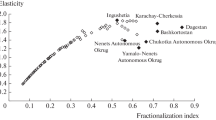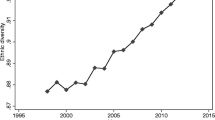Abstract.
This paper analyzes the welfare effects of immigration and its subsequent effect on ethnic diversity in a model featuring human capital spillovers which depend on the degree of ethnic heterogeneity, variation rates of time preference across individuals and endogenous levels of immigration and assimilation. In the model, an increase in ethnic diversity reduces the spillovers effect for the majority. Nonetheless, immigration can be welfare improving for the majority ethnic group even if it increases the degree of diversity as long as it raises the average human capital level and/or growth rate by increasing the proportion of people with low rates of time preference. However, if an economy is too homogenous, it will not be able to attract immigrants. Finally, if the level of immigration is not too high, then immigration also raises the net benefits to assimilation which leads to a more homogenous economy.
Similar content being viewed by others
Author information
Authors and Affiliations
Additional information
Received: 18 February 1997 / Accepted: 16 July 1997
Rights and permissions
About this article
Cite this article
Durkin Jr., J. Immigration, assimilation and growth. J Popul Econ 11, 273–291 (1998). https://doi.org/10.1007/s001480050069
Issue Date:
DOI: https://doi.org/10.1007/s001480050069




